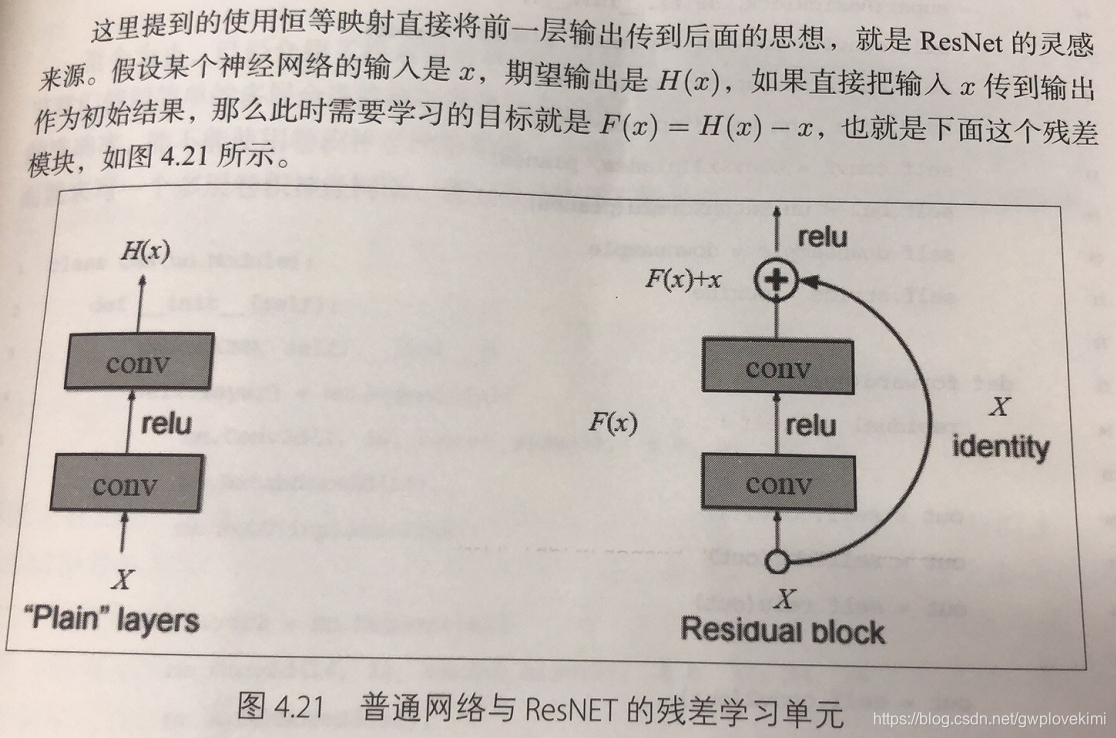學習筆記之——基於pytorch的殘差網路(deep residual network)
阿新 • • 發佈:2018-11-30
本博文為本人學習pytorch系列之——residual network。
前面的博文( 學習筆記之——基於深度學習的分類網路)也已經介紹過ResNet了。ResNet是2015年的ImageNet競賽的冠軍,由微軟研究院提出,通過引入residual block能夠成功地訓練高達152層的神經網路。
(paper的連結:https://arxiv.org/pdf/1512.03385.pdf )
在不斷加深神經網路的時候,會處出現一個Degradation,即準確率會先上升然後達到飽和,再繼續增加深度則會導致模型的準確率下降(由於梯度消失和梯度爆炸)提出的殘差塊的結構如下圖所示:


好,下面給出程式碼
import torch import torch.nn as nn import torchvision #It includes the popular data set, model structure and commonly used image conversion tools. import torchvision.transforms as transforms #Device configuration device=torch.device('cuda:0'if torch.cuda.is_available() else 'cpu') #Hyper parameters num_epochs=80 #num_classes=10#number 0~9 batch_size=100 learning_rate=0.001 #Image preprocessing modules #in here we use the data arguement in pytorch transform=transforms.Compose([ transforms.Pad(4),#Zero boundary fill for pictures transforms.RandomHorizontalFlip(),#Random horizontal flip with probability of 0.5 transforms.RandomCrop(32),#Random clipping of pictures for a given size. transforms.ToTensor() ]) #CIFAR-10 dataset train_dataset=torchvision.datasets.CIFAR10(root='./CIFAR10_data',train=True,transform=transform,download=True) test_dataset=torchvision.datasets.CIFAR10(root='./CIFAR10_data',train=False,transform=transforms.ToTensor()) #data loader train_loader=torch.utils.data.DataLoader(dataset=train_dataset,batch_size=batch_size,shuffle=True) test_loader=torch.utils.data.DataLoader(dataset=test_dataset,batch_size=batch_size,shuffle=False) ########################################################## #residual block class Residual_Block (nn.Module): def __init__(self,i_channel,o_channel,stride=1,downsample=None): super(Residual_Block,self).__init__() self.conv1=nn.Conv2d(in_channels=i_channel,out_channels=o_channel,kernel_size=3,stride=stride,padding=1,bias=False) self.bn1=nn.BatchNorm2d(o_channel) self.relu=nn.ReLU(inplace=True) self.conv2=nn.Conv2d(in_channels=o_channel,out_channels=o_channel,kernel_size=3,stride=1,padding=1,bias=False) self.bn2=nn.BatchNorm2d(o_channel) self.downsample=downsample def forward(self,x): residual=x out=self.conv1(x) out=self.bn1(out) out=self.relu(out) out=self.conv2(out) out=self.bn2(out) if self.downsample: residual=self.downsample(x) out+=residual out=self.relu(out) return out ############################################################## #ResNet class ResNet(nn.Module): def __init__(self,block,layers,num_classes=10): super(ResNet,self).__init__() self.in_channels=16 self.conv=nn.Conv2d(in_channels=3,out_channels=16,kernel_size=3,stride=1,padding=1,bias=False) self.bn=nn.BatchNorm2d(16) self.relu=nn.ReLU(inplace=True) self.layer1=self.make_layer(block,16,layers[0]) self.layer2=self.make_layer(block,32,layers[0],2) self.layer3=self.make_layer(block,64,layers[1],2) self.avg_pool=nn.AvgPool2d(8) self.fc=nn.Linear(64,num_classes) def make_layer(self,block,out_channels,blocks,stride=1):#blocks=layers,the number of residual block downsample=None if (stride!=1) or (self.in_channels !=out_channels): downsample=nn.Sequential( nn.Conv2d(self.in_channels,out_channels,kernel_size=3,stride=stride,padding=1,bias=False), nn.BatchNorm2d(out_channels) ) layers=[] layers.append(block(self.in_channels,out_channels,stride,downsample)) self.in_channels=out_channels for i in range(1,blocks): layers.append(block(out_channels,out_channels)) return nn.Sequential(*layers)# add all of the residual block def forward(self,x): out = self.conv(x) out = self.bn(out) out = self.relu(out) out = self.layer1(out) out = self.layer2(out) out = self.layer3(out) out = self.avg_pool(out) out = out.view(out.size(0), -1) out = self.fc(out) return out model=ResNet(Residual_Block,[2,2,2,2]).to(device) #loss and optimizer criterion=nn.CrossEntropyLoss() optimizer=torch.optim.Adam(model.parameters(),lr=learning_rate) #for updating learning rate def update_lr(optimizer,lr): for param_group in optimizer.param_groups: param_group['lr']=lr ######################################################################## #train the model total_step=len(train_loader) curr_lr=learning_rate for epoch in range(num_epochs): for i,(images,labels) in enumerate(train_loader): images=images.to(device) labels=labels.to(device) #forward pass outputs=model(images) loss=criterion(outputs,labels) #Backward and optimize optimizer.zero_grad() loss.backward() optimizer.step() if (i+1)%100==0:#each 100 iterations is one epoch print("Epoch [{}/{}],step[{}/{}] Loss:{:.4f}" .format(epoch+1,num_epochs,i+1,total_step,loss.item())) #decay the learning rate if (epoch+1)%20==0:#each 20 epoch, decay the learning rate curr_lr/=3 update_lr(optimizer,curr_lr) #test the model model.eval() with torch.no_grad(): correct=0 total=0 for images, labels in test_loader: images=images.to(device) labels=labels.to(device) outputs=model(images) _,predicted=torch.max(outputs.data,1) total+=labels.size(0) correct+=(predicted==labels).sum().item() print('accuracy of the model on the test images: {}%' .format(100*correct/total)) #save the model checkpoint #torch.save(model.state_dict(),'resnet.ckpt')
結果(執行過程出了挺多bug的hhh,coding能力還是有待提升哎)


關於資料增廣
通過資料增廣可以提高模型的準確率和泛化能力。


firefox崩掉了,可以採用下面指令
ps -ef | grep firefox | awk '{print $2}' | xargs kill -9
